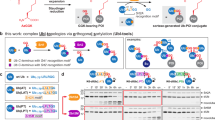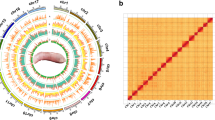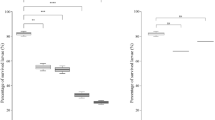Abstract
5-BROMODEOXYURIDINE (BUdR), an analogue of thymidine, has been shown to selectively inhibit cell differentiation in various cell types and development of embryos, without affecting cell maintenance capabilities1. Gontcharoff and Mazia2 demonstrated that exposure of newly fertilised sea urchin eggs or early cleavage stage embryos to BUdR resulted in embryos which did not gastrulate or produce echinochrome pigment. From this laboratory evidence has been reported3 for a BUdR-induced modification of DNA replication in developing sea urchin embyros. Pulse-chase experiments in sea urchin gastrulae demonstrated that newly synthesised low molecular weight (8-15S) nuclear DNA labelled with 3H-BUdR was not readily chased by unlabelled BUdR into higher molecular weight DNA. In contrast, 8-15S DNA labelled with 3H-thymidine was converted into higher molecular weight DNA during a relatively short chase period with unlabelled thymidine. This data suggested the incorporation of BUdR into newly synthesised low molecular weight DNA molecules in embryos might prevent or slow the rate of normal linkage of such molecules into higher molecular weight DNA.
This is a preview of subscription content, access via your institution
Access options
Subscribe to this journal
Receive 51 print issues and online access
$199.00 per year
only $3.90 per issue
Buy this article
- Purchase on SpringerLink
- Instant access to full article PDF
Prices may be subject to local taxes which are calculated during checkout
Similar content being viewed by others
References
Rutter, W. J., Pictet, R. L., and Morris, P. W., A. Rev. Biochem., 42, 601–646 (1973).
Gontcharoff, M., and Mazia, D., Expl Cell Res., 46, 315–327 (1967).
Kotzin, B. L., and Baker, R. F., J. Cell Biol., 55, 74–81 (1972).
Piko, L., Tyler, A., and Vinograd, J., Biol. Bull., 132, 68–90 (1967).
Piko, L., Am. Zool., 9, 1118 (1969).
Birnboim, H. C., Mitchel, E. J., and Straus, N. A., Proc. natn. Acad. Sci. U.S.A., 70, 2189–2192 (1973).
Baker, R. F., Biochem. biophys. Res. Commun., 43, 1415–1420 (1971).
Walther, B. T., David, J. D., Levine, S., Pictet, R., and Rutter, W. J., Fedn Proc., 30, 1128 (1971).
Callan, H. G., Proc. R. Soc. B/ 181, 19–41 (1972).
Taylor, J. H., Adams, A. G., and Kurek, M.P., Chromosoma, 41, 361–384 (1973).
Tyler, A., Biol. Bull., 104, 224–229 (1953).
Thomas, jun., C. A., and Abelson, J., in Procedures in Nucleic Acid Research (edit. by Cantoni, G. L. and Davies, D. R.), 553–561 (Harper and Row, New York. 1966).
Studier, F. W., J. molec. Biol., 11, 373–390 (1965).
Davidson, N., and Szybalski, W., in The Bacteriophage Lambda (edit. by Hershey, A. D.), 48 (Cold Spring Harbor Laboratory, New York, 1971).
Author information
Authors and Affiliations
Rights and permissions
About this article
Cite this article
BAKER, R., CASE, S. Effect of 5-bromodeoxyuridine on the size distribution of DNAs isolated from sea urchin embryos. Nature 249, 350–352 (1974). https://doi.org/10.1038/249350b0
Received:
Issue date:
DOI: https://doi.org/10.1038/249350b0



